Perhaps people who are completely indifferent to ornamental plants and do not seek to decorate their home with flowers in pots and tubs are a rarity. Indeed, green pets and the house are decorated, and the air is cleaned, and does not require much time for care. As for preferences, they, of course, are different for everyone. Someone is content with the most common and unpretentious home decorative plants, but someone likes exotic, and then you can set yourself a more complex and interesting task. For example, how to grow a banana at home? It is not that easy, but quite real. In tropical countries, banana cultivation is carried out on an industrial scale, but in the northern regions their decorative qualities are appreciated.
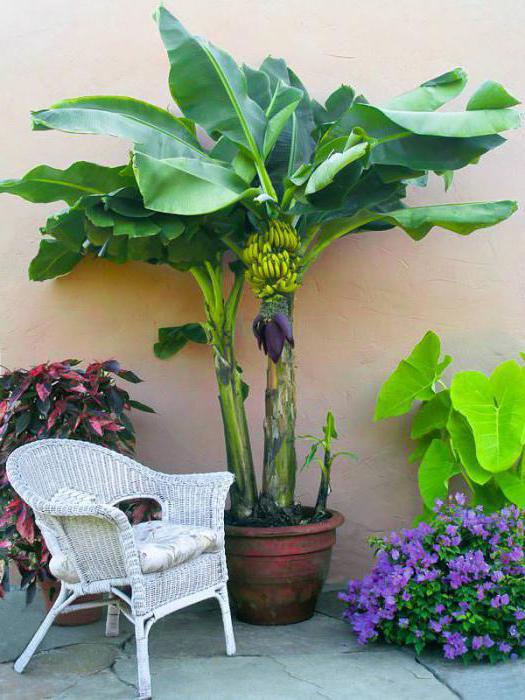
Banana: is it really grass?
Not so long ago, the fruits of banana were absolutely exotic for our country. Now, of course, they will not surprise anyone, but far from everyone knows what the plant itself is. If you have thoughts about how to grow a banana at home, it will not be out of place to know that this is not a palm tree at all, although it very much resembles it. Banana is a perennial herb. It has a powerful root system, but no trunk at all. There is a stalk, but it hardly protrudes above the surface of the earth. What is usually taken as a trunk is actually a tube of petioles of banana leaves arranged in a spiral and tightly inserted into each other.
It is difficult to believe in the grassy nature of a banana because this plant under natural conditions can reach an average height of 2 to 9 m. Some species grow even higher, making banana, along with bamboo, the tallest herbs in the world. Do not be afraid of this height if you are in doubt whether it is possible to grow a banana at home: its decorative varieties rarely grow above 1.5 m.
Banana as an ornamental plant. Banana leaves
Florists who are interested in the question of how to grow a banana at home are not attracted to this plant by its fruits, which, incidentally, are rarely edible in decorative varieties. Some species have extremely spectacular leaves, while others are valued for original flowers. Cultivated banana varieties are a hybrid species that is not found in nature.
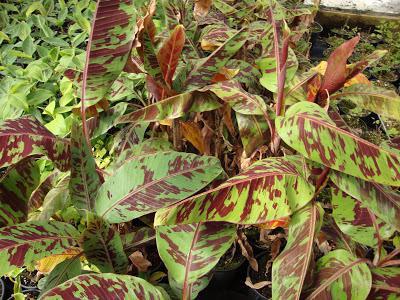
Banana leaves are large, oblong, with parallel veins along which they easily tear under strong winds or rain, thereby reducing the shock load on the plant. Depending on the variety, they can be completely green, or covered with crimson spots. Sometimes the leaves are green only on top, and on the inside - red-violet. The plant grows very quickly: in just a week under optimal conditions, one leaf is able to fully grow.
How a banana blooms
Banana begins to bloom on average in the third year of life. A bud of red, purple, lavender or yellow (rarely) color appears on the top of the plant and, as it blooms, most often drops down. In the inflorescence there are female flowers, from which the fruits, bisexual and male, develop. It is interesting that in the inflorescence development proceeds continuously: while the upper flowers are pollinated, the fruits ripen below. How to grow a banana at home, in order to be able to admire the fascinating process of its flowering, which can last almost a whole year, will be described below.
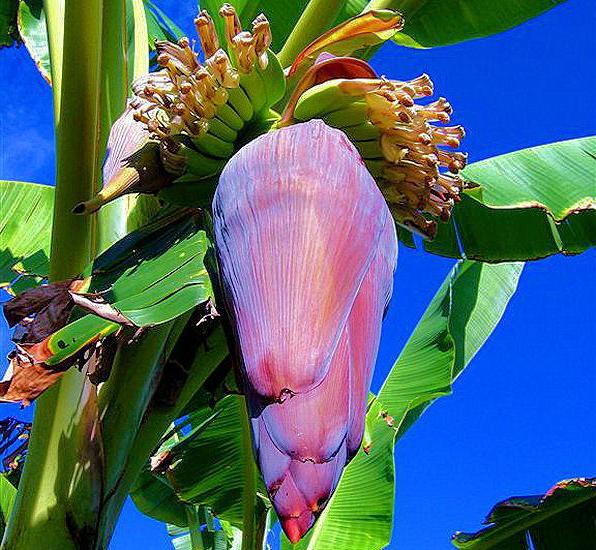
Banana propagation
Although the banana fruit is, from the point of view of botany, a multi-seeded berry, it is often devoid of seeds in cultural forms.The reproduction of such plants occurs in a vegetative manner: by bearing fruit, it dies and is replaced by a new root process. Wild plants in the pulp of fruits can have up to 200 pieces of hard seeds of a pointed form. Their length can be different and range from 3 to 16 mm.
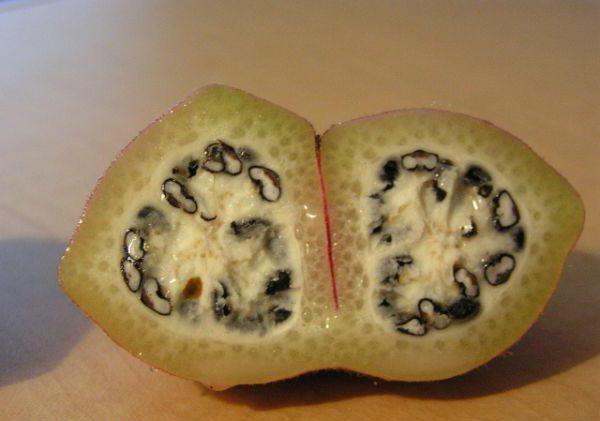
The easiest way to think about how to grow a banana at home is to purchase a ready-made shoot in the flower salon. Different types of ornamental plants can be offered there: from one that can be kept in a pot on a table, to a rather high one for a spacious room, a winter garden or a greenhouse.
How to grow a banana at home from seeds: the preparatory phase
Experienced gardeners can be very interested in such a painstaking task as growing a banana from a seed at home. First you need to soak the seeds for at least a day in warm water, replacing it several times. When the hard shell softens slightly, it should be slightly scratched with a nail file or sandpaper, or pricked with a large needle, being careful not to damage the core. This process is called mechanical scarification and facilitates the germination of seeds that, like the banana, are protected by a very strong shell.
Planting seeds
Next, we grow banana from the seed at home as follows: you need to plant the prepared seeds in a mixture of sand and peat to a depth not exceeding their size, and find a bright and warm place for the container with heating at about 30º C (possible on the battery), covering it with glass and making sure that the soil in it is constantly slightly moist. It is possible that in such mini-greenhouses shoots appear in 2-3 weeks, but it is possible that you will have to be patient and wait a little longer, sometimes up to 10 weeks. However, appearing, the sprouts grow very quickly.
After the appearance of 2-3 sheets of seedlings, they can be dived into separate containers. In the first year of life, the banana will have to be transplanted repeatedly, each time choosing a larger pot and planting a little deeper than the previous time - this contributes to the formation of additional roots. Be sure to equip a good drainage at the bottom of the pot and use neutral soil for planting.
Plants grown from seeds are more viable than propagated vegetatively, but, as a rule, almost always have inedible fruits.
Optimal conditions for a banana
In an effort to collect as much information as possible about how to grow a banana at home, you must remember that this plant comes from the tropics of Southeast Asia. Therefore, in order for it to feel good, it is necessary to recreate for it the conditions of the homeland. And that implies temperature condition within 22-26 ºС, without sharp fluctuations, high humidity and a lot of light. In winter, it is worthwhile to arrange additional lighting for the banana, so that daylight hours last at least 14 hours a day. At the same time, it is better to provide diffused light, and slightly shade the plant at noon. Drafts and sudden changes in temperature will destroy the banana.
In the summer, banana is watered abundantly, however, preventing stagnation of water in the pan. In winter, if the air temperature is at the level of 18-20 ºС, watering must be reduced and the plant should have a rest period. The plant loves regular spraying (in summer this procedure can be performed daily) and wiping the leaves with a wet sponge.
Due to the active growth, the plant is fed weekly in the summer, in winter it can be carried out once a month, preferably using organic fertilizers.
Popular varieties of decorative banana
Now, knowing the basic information about how to grow a banana from seeds at home (see the photo of the plant in the review), you might think which sort of tropical beauty should be preferred.
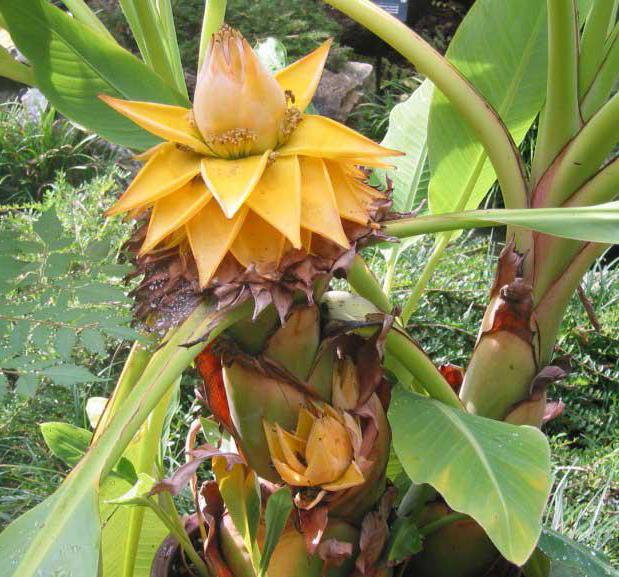
The Golden Lotus is named for its large yellow flowers. It grows in the highlands of China.Able to tolerate reduced air temperature, flesh to zero.
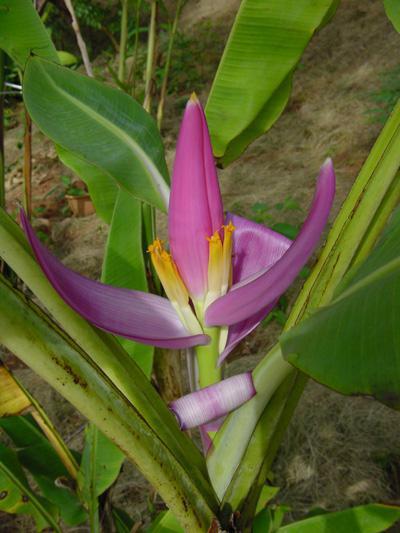
Lavender banana has spectacular bright yellow flowers with lilac bracts and grows well in room conditions.
Bloody banana, with wine-red spots on the leaves, is attractive even outside the flowering period, the fruit is inedible. Pink velvet banana is distinguished by bright green leaves and pink flowers, which are replaced by small fleecy edible fruits of the same shade with many seeds inside.

Scarlet banana owes its name to bright bracts of red-orange color. This is not a very high grade, reaches a maximum of 1 m.
Dwarf banana grows to 1.5 m, the fruit is sweet and quite large. Japanese banana is the most cold-resistant species, for this reason it can be cultivated in the open ground of the southern regions of Russia. The fruits of this variety are inedible.








